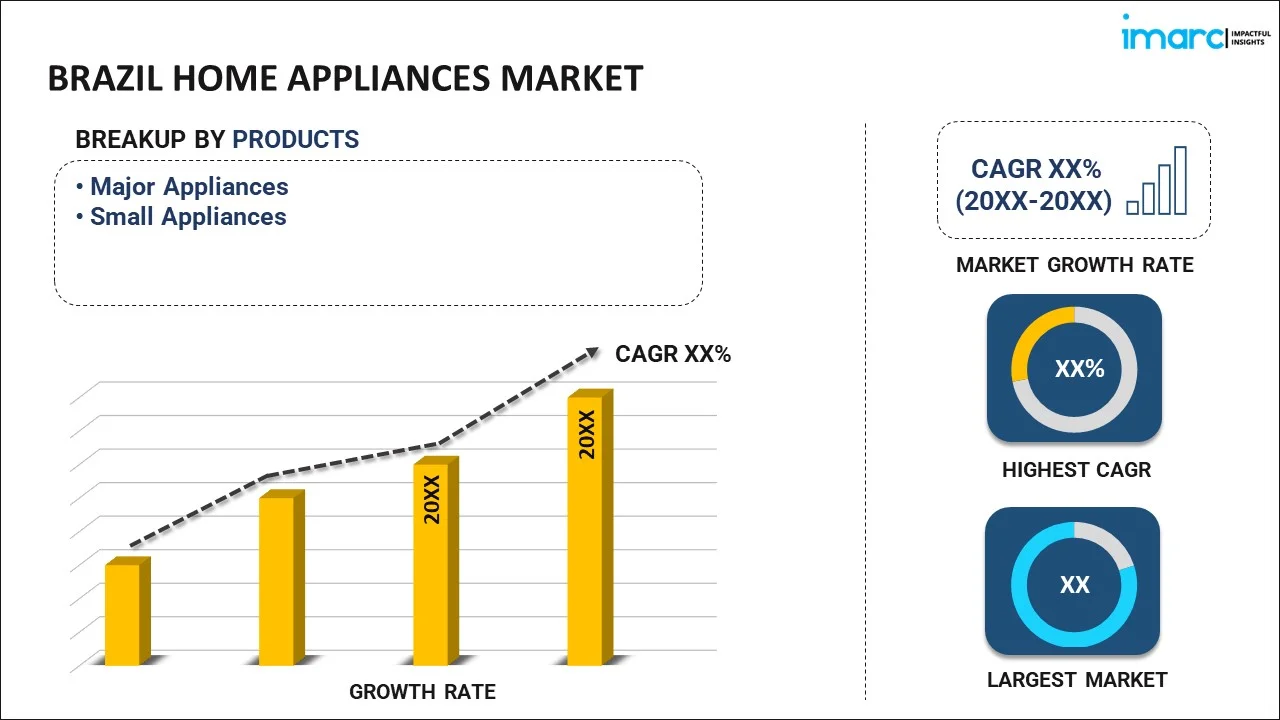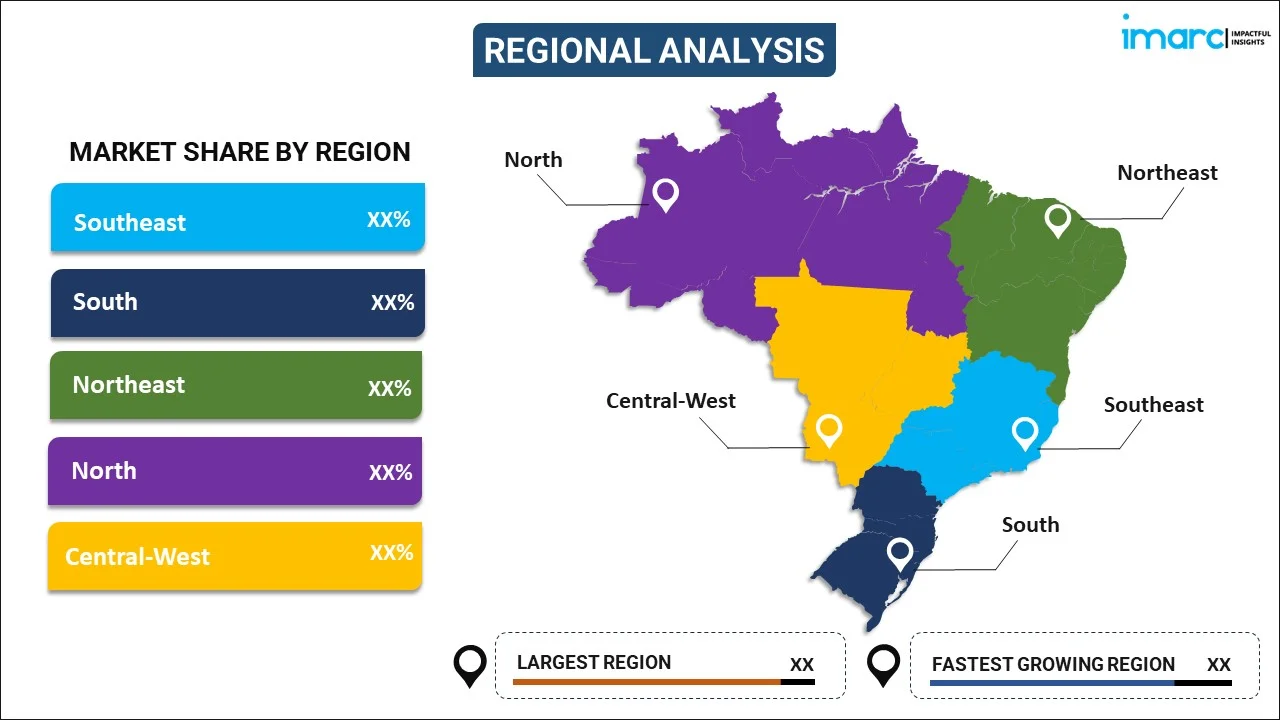
Brazil Home Appliances Market Report by Product (Major Appliances, Small Appliances), Distribution Channel (Supermarkets and Hypermarkets, Specialty Stores, E-commerce, and Others), and Region 2024-2032
Market Overview:
Brazil home appliances market size is projected to exhibit a growth rate (CAGR) of 3.02% during 2024-2032. The rapid economic growth and urbanization, changing lifestyle patterns, increasing environmental awareness, favorable government initiatives, rising housing construction, significant technological advancements, rising competition, rapidly growing e-commerce sector represent some of the key factors driving the market.
|
Report Attribute
|
Key Statistics
|
|---|---|
|
Base Year
|
2023 |
|
Forecast Years
|
2024-2032
|
|
Historical Years
|
2018-2023
|
| Market Growth Rate (2024-2032) | 3.02% |
Home appliances are everyday devices designed to simplify and enhance various household tasks and chores. These indispensable machines are essential in modern homes, contributing to increased convenience, efficiency, and overall quality of life. Some of the most commonly available home appliances include refrigerators, washing machines, dishwashers, stoves, ovens, microwaves, and vacuum cleaners. Refrigerators, for instance, keep perishable food items fresh for extended periods, reducing food wastage and ensuring a consistent supply of essentials. Washing machines and dishwashers streamline laundry and dishwashing, saving time and effort. Stoves, ovens, and microwaves are vital for cooking and heating meals quickly and efficiently, while vacuum cleaners help maintain clean and hygienic living spaces.
Brazil Home Appliances Market Trends:
The economic growth and urbanization have led to an rise in disposable income and a rising middle class respectively. As more individuals move to urban areas, the demand for modern home appliances, such as refrigerators, washing machines, and air conditioners, has increased. Additionally, the changing lifestyle patterns of Brazilian consumers, including longer working hours and busy lifestyles, have boosted the demand for time-saving and convenient appliances. This trend has driven the market for products like microwave ovens, dishwashers, and coffee makers. Other than this, growing awareness about environmental issues and the need for energy efficiency has influenced consumer preferences. Energy-efficient appliances, marked with high energy efficiency ratings, are in high demand, aligning with Brazil's sustainability goals. Besides this, the construction of new housing units and residential complexes has contributed to increased appliance sales, as these new homes require a range of appliances to be fully functional. In line with this, advancements in technology, including the rise of smart home appliances, have stimulated the interest of tech-savvy consumers. Products with features like Wi-Fi connectivity and smart controls have gained popularity. Apart from these factors, the emerging e-commerce industry in Brazil has made it easier for consumers to access a broad range of home appliances online. This convenience factor has driven online sales and influenced purchasing behavior. Furthermore, growing competition among home appliance manufacturers has led to continuous innovation and product development. This has resulted in a wider variety of options for consumers, fostering market growth. moreover, the availability of comprehensive after-sales services, including warranties and repairs, plays a crucial role in the decisions of consumers to purchase home appliances. The Brazilian government has introduced various incentive programs and tax breaks to promote the production and adoption of energy-efficient appliances. These initiatives have positively impacted the market by encouraging manufacturers to innovate in this direction.
Brazil Home Appliances Market Segmentation:
IMARC Group provides an analysis of the key trends in each segment of the market, along with forecasts at the country level for 2024-2032. Our report has categorized the market based on product and distribution channel.
Product Insights:

- Major Appliances
- Refrigerators
- Freezers
- Dishwashing Machines
- Washing Machines
- Ovens
- Air Conditioners
- Others
- Small Appliances
- Coffee/Tea Makers
- Food Processors
- Grills and Roasters
- Vacuum Cleaners
- Others
The report has provided a detailed breakup and analysis of the market based on the product. This includes major appliances (refrigerators, freezers, dishwashing machines, washing machines, ovens, air conditioners, and others) and small appliances (coffee/tea makers, food processors, grills and roasters, vacuum cleaners, and others).
Distribution Channel Insights:
- Supermarkets and Hypermarkets
- Specialty Stores
- E-commerce
- Others
A detailed breakup and analysis of the market based on the distribution channel have also been provided in the report. This includes supermarkets and hypermarkets, specialty stores, e-commerce, and others.
Regional Insights:

- Southeast
- South
- Northeast
- North
- Central-West
The report has also provided a comprehensive analysis of all the major regional markets, which include Southeast, South, Northeast, North, and Central-West.
Competitive Landscape:
The market research report has also provided a comprehensive analysis of the competitive landscape in the market. Competitive analysis such as market structure, key player positioning, top winning strategies, competitive dashboard, and company evaluation quadrant has been covered in the report. Also, detailed profiles of all major companies have been provided.
Brazil Home Appliances Market Report Coverage:
| Report Features | Details |
|---|---|
| Base Year of the Analysis | 2023 |
| Historical Period | 2018-2023 |
| Forecast Period | 2024-2032 |
| Units | US$ Million |
| Scope of the Report | Exploration of Historical and Forecast Trends, Industry Catalysts and Challenges, Segment-Wise Historical and Predictive Market Assessment:
|
| Products Covered |
|
| Distribution Channels Covered | Supermarkets and Hypermarkets, Specialty Stores, E-commerce, Others |
| Regions Covered | Southeast, South, Northeast, North, Central-West |
| Customization Scope | 10% Free Customization |
| Report Price and Purchase Option | Single User License: US$ 3699 Five User License: US$ 4699 Corporate License: US$ 5699 |
| Post-Sale Analyst Support | 10-12 Weeks |
| Delivery Format | PDF and Excel through Email (We can also provide the editable version of the report in PPT/Word format on special request) |
Key Questions Answered in This Report:
- How has the Brazil home appliances market performed so far and how will it perform in the coming years?
- What has been the impact of COVID-19 on the Brazil home appliances market?
- What is the breakup of the Brazil home appliances market on the basis of product?
- What is the breakup of the Brazil home appliances market on the basis of distribution channel?
- What are the various stages in the value chain of the Brazil home appliances market?
- What are the key driving factors and challenges in the Brazil home appliances?
- What is the structure of the Brazil home appliances market and who are the key players?
- What is the degree of competition in the Brazil home appliances market?
Key Benefits for Stakeholders:
- IMARC’s industry report offers a comprehensive quantitative analysis of various market segments, historical and current market trends, market forecasts, and dynamics of the Brazil home appliances market from 2018-2032.
- The research report provides the latest information on the market drivers, challenges, and opportunities in the Brazil home appliances market.
- Porter's five forces analysis assist stakeholders in assessing the impact of new entrants, competitive rivalry, supplier power, buyer power, and the threat of substitution. It helps stakeholders to analyze the level of competition within the Brazil home appliances industry and its attractiveness.
- Competitive landscape allows stakeholders to understand their competitive environment and provides an insight into the current positions of key players in the market.
Need more help?
- Speak to our experienced analysts for insights on the current market scenarios.
- Include additional segments and countries to customize the report as per your requirement.
- Gain an unparalleled competitive advantage in your domain by understanding how to utilize the report and positively impacting your operations and revenue.
- For further assistance, please connect with our analysts.
 Inquire Before Buying
Inquire Before Buying
 Speak to an Analyst
Speak to an Analyst
 Request Brochure
Request Brochure
 Request Customization
Request Customization




.webp)




.webp)












